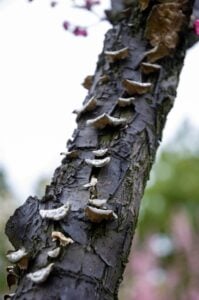Table of Contents
Is Fungus on a Tree Harmful? Signs You Shouldn’t Ignore
Tree fungus can be one of the earliest and clearest signs that your tree is under stress, in decline, or even dying. And in many cases, doing nothing allows the problem to spread across your entire landscape. For Montclair homeowners, understanding what different fungal growths mean is essential. Learn why fungus forms, what it could signal, and how to handle it before it’s too late.
What Causes Fungus to Grow on Trees?
- Fungi thrive in cool, moist, and shaded environments. In Montclair, where we experience seasonal rains and humidity, trees are naturally vulnerable to fungal infections, especially if they’re already under stress from drought, pests, root damage, or poor soil.
Fungal spores often enter through:
- Wounds in bark caused by pruning, weather, or mechanical damage
- Insect infestations that weaken tree defenses
- Saturated soil or poor drainage
- Nearby infected plants or decomposing organic matter
Once inside, fungi can take hold quickly, especially if the tree lacks the strength to fight it off.
Common Signs of Fungal Infections
Fungus doesn’t always appear as the classic mushroom cap at the base of a tree. Here are a few warning signs Montclair residents should watch for:
- Shelf-like fungi (like conks or bracket fungus) growing from the trunk or limbs
- Powdery mildew covering leaves with a white or gray film
- Cankers or oozing lesions on bark or branches
- Wilting, yellowing, or premature leaf drop
- Dark spotting on leaves (often a sign of anthracnose)
- Root rot symptoms, including a foul odor near the trunk base or soft wood
If you notice any of these issues, it’s advisable to have a professional inspection conducted.
Is Fungus on a Tree Always Harmful?
- Not every fungus is deadly, but none should be ignored. Some fungal infections are saprophytic, they feed on dead wood and may not harm healthy trees. However, others are pathogenic and can damage or destroy living tissue.
Non-harmful Fungi
- Often grow on dead branches or stumps. These don’t usually require removal but should still be monitored.
Harmful Fungi
- Like Armillaria (honey fungus), Ganoderma, and Verticillium wilt, these can rot wood from the inside, compromise the tree’s structure, and even spread underground to nearby trees.
The challenge is that even arborists often need to inspect closely to determine which type you’re dealing with. A fungal infection that seems minor could be rotting your tree from the inside out.
Why Early Detection Matters?
Waiting too long can be costly. Trees with advanced fungal infections are more likely to:
- Lose large limbs without warning
- Become structurally unstable
- Transmit the infection to neighboring trees
- Require emergency removal
In many cases, early treatment through pruning, soil treatment, or antifungal applications can slow or stop the spread. Once decay advances too far, however, your only option may be removal to protect the rest of your yard.
Conclusion

- Fungus on a tree is never something to overlook. Even if it looks harmless, it could be a sign of something more serious beneath the surface. Whether it’s a cosmetic issue or a structural threat, a quick inspection can make all the difference. If you’re in Montclair and have noticed unusual growths or changes in your trees, reach out to American Tree Experts, Inc.
We offer the best services to keep your plants out of harm’s way. Our pest management services ensure your trees are protected from damaging insects and diseases all year round. Some of our most sought-after services include expert pruning, structural bracing, pest control, and tailored nutritional management. We proudly serve homeowners and businesses throughout Montclair, New Jersey, and surrounding areas. Call us today at 973-744-6091 for a free quote and let our certified arborists help your landscape thrive.
